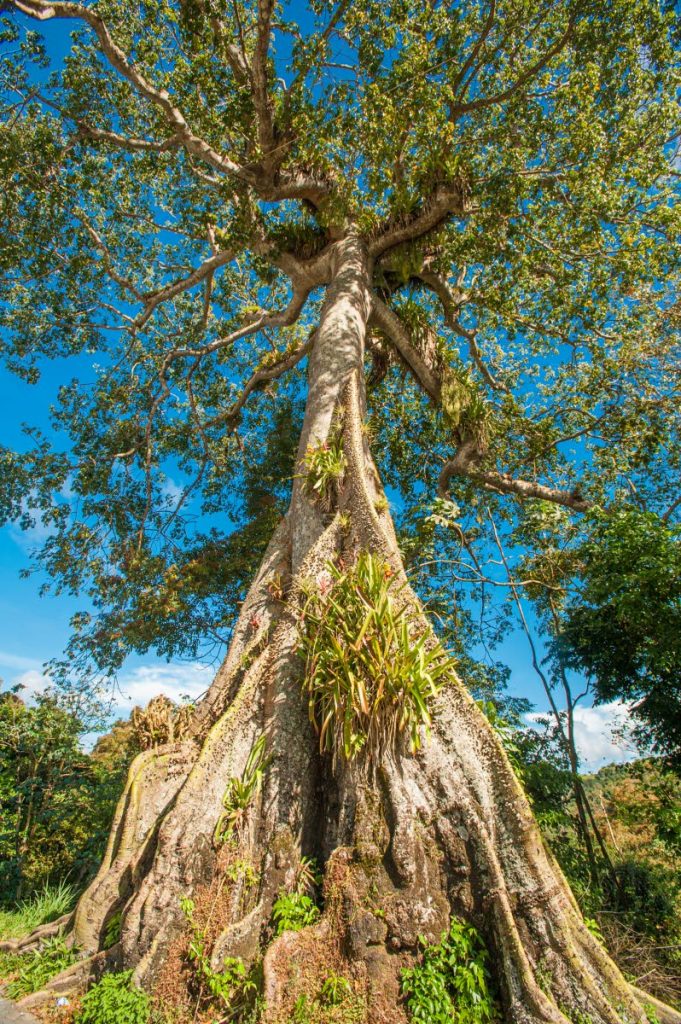Ancestors weep: lessons from silk cotton tree

By DR RITA PEMBERTON
There was no indication that year 2020 would provide an unusual confluence of water, disease and culture which would inflict a severe blow to Tobago’s heritage. But the year ended as it began, with water management problems that proved detrimental to Tobago.
At the very start of the year, concerns about the island’s water supply commanded administrative attention amid the reality of a fierce dry season and reduced rainfall. The resulting subnormal water levels at the Hillsborough Dam led to the implementation of strict water restrictions which were challenged by covid19 and the increased demand for water to sanitise.
As the disease spread, control over the size of gatherings had a serious impact on the much anticipated Heritage Festival, the highlight of Tobago’s annual event calendar which was transformed to a virtual celebration. No one could have predicted the unfortunate turn of events that would occur during the last month of the year with its jolt on heritage activity.
The silk cotton tree (Ceiba pentandra (L) Gaertn), also known as the ceiba tree , the kapok tree and the kumaka tree in different parts of the tropics, is one of the largest indigenous trees in the region. It also grows in West Africa and is native to Tobago, where it is locally referred to as the Jumbie Tree, which emanates from the indigenous and African belief that spirits live in the trees of the forests.
Specifically, it is a Yoruba belief that the spirits of those who died by hanging or any other horrible form of death lived in large forest trees. The fact that the silk cotton tree was commonly used on the plantations for making examples of those enslaved resisters by hanging and other forms of punishment, gave credence to the belief that the tree was home to the ancestors.
The tree has played an important role in the spiritual and cultural life of the people of Tobago. While there are several trees across the island, the two most famous are those located at Culloden and Runnemede on the Northside Road.
The rains poured in November. The Hillsborough dam attained 100 per cent capacity, resolving one aspect of the water problem, but the continuing deluge created another.
On the afternoon of Wednesday, December 2, after hours of heavy rainl, Tobago was stunned by the news that one of its longstanding heritage items and an important symbol of its culture had fallen victim to the waterlogged soil.
The uprooted silk cotton tree crashed across the Culloden Bay Road, taking with it power lines, damaging two cars and isolating the Culloden community for over five hours. This tree is an unheralded plantation relic holding modern-day significance that extends far beyond the plantations, tourism and the visible physical impact of its demise.
This tree assumed historic importance as a tourist curio related to the story of Gang Gang Sarah, whose grave is in Golden Lane.
Gang-Gang Sarah was an enslaved woman who, according to oral tradition, flew from West Africa to Tobago to take spiritual care of the enslaved Africans on the island. After Emancipation, she attempted to fly back to her homeland by taking off from the top of a tall silk cotton tree, but as she took off she fell to her death having lost her power to fly because she had eaten salt while in Tobago.
Unfortunately, the very important lessons to be learned from this account has escaped those who trivialise the story.
The historic centuries-old tree which stood tall, proud and strong, resisting previous precarious weather challenges – even that of Hurricane Flora in 1963 – was a living reminder of the enslavement of the African-descended population and with its companion on the Northside Road, in the absence of any other, served as nature’s monument to the labour, practices, experiences and beliefs of the African population in Tobago.
For the Yorubas and other African groups, oral traditions are used to teach moral lessons, valour and life lessons, in some instances with coded messages. It is therefore essential that the African-descended population of Tobago obtain a full understanding of the African-derived aspects of their cultural practices and heritage.
This sad event was not a chance occurrence, because for a full two weeks prior to its demise, the anguished cries of the ancestors were expressed in the creaks and groans that emanated from the tree in Culloden.
Timed just after the termination of African History Month and a mere two days before the THA celebrated its 40th anniversary, the fall of the tree can be seen as a message from the ancestors for Tobago generally and its administration in particular, to pay serious attention to the island’s African history and heritage.
Over the years, without human involvement, the tree symbolised Tobago’s commemoration of special days of remembrance of the enslavement: March 25, the International Day of Remembrance of the Victims of Slavery and the Transatlantic Slave Trade, which was established as the opportunity to honour and remember those who suffered and died at the hands of the brutal slavery system; and Slavery Remembrance Day on August 23 to honour the victims of slavery and the Transatlantic Slave Trade.
The silence in Tobago on what should always be special days on the island’s calendar is deafening. The ancestors groan!
Having carried that role without human support or encouragement, it is a travesty of justice that the Courlanders, enslavers who brought 109 enslaved Africans to Tobago in 1660 have a monument on the island which reflects their pride in their colonising effort, but which makes no mention of the enslaved Africans they introduced, exploited and abused. The ancestors bawl!
The Dutch, who started the trade and brought 984 captive Africans to the island, and the British, who brought 1994 during the 18th century, have place names including Dutch Fort and Fort King George in their honour. What of those who bore the burden of colonisation without compensation? Even Emancipation Day does not appear to be a cause célèbre on the island. The ancestors scream!
Despite the central role afforded to Gang-Gang Sarah, in the tourism drive her grave site remains in a state of dilapidation that cannot be considered visitor-ready. Even the ANR Robinson tomb remains unfinished. The ancestors cringe!
What is also very evident is the fact that the lessons to be learned from Gang-Gang Sarah’s story appear not to be recognised on the island. The ancestors wail!
That she lost her skills through salt consumption is an important consideration for the descendants of enslaved Africans. The heavily salted diet of the enslaved Africans has had long-term debilitating effect on the health of succeeding generations. This accounts for the high rate of diabetes on the island, a health issue that is virtually unknown in West Africa.
The desire to return to Africa is reminiscent of escape, resistance to enslavement and its conditions which characterised enslavement, and the conviction that she could still fly represents her confidence in the African belief system which helped to support African survival during enslavement. Her death mimics the death of the hundreds of enslaved Africans who were hung in those trees for daring to resist their enslavers. For all this the ancestors weep!
With one tree gone, it is clear that trees can only be temporary representations of Tobago’s historical experience. More than anything else, Tobago needs a permanent memorial to the thousands of enslaved Africans who were captured and shipped to Tobago, those who died during the journey or on the plantations from overwork or as a punishment. The most appropriate way to preserve this aspect of the island’s history is to replant a tree on the site, establish a permanent monument and facilitate public education on the African experience in Tobago.
The silk cotton tree has spoken and the message conveyed. Pour a libation, appease the ancestors, break the silence and restore ancestral pride in the island!
Oh ha, Oh ha ha! Drag yuh bow, Mr Fiddler!
.



Comments
"Ancestors weep: lessons from silk cotton tree"